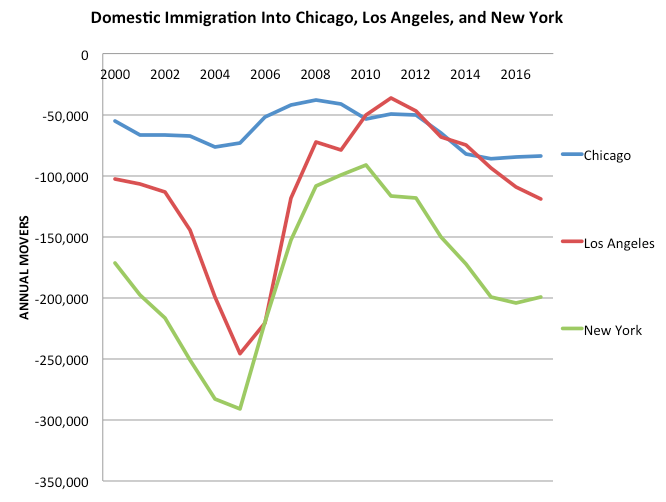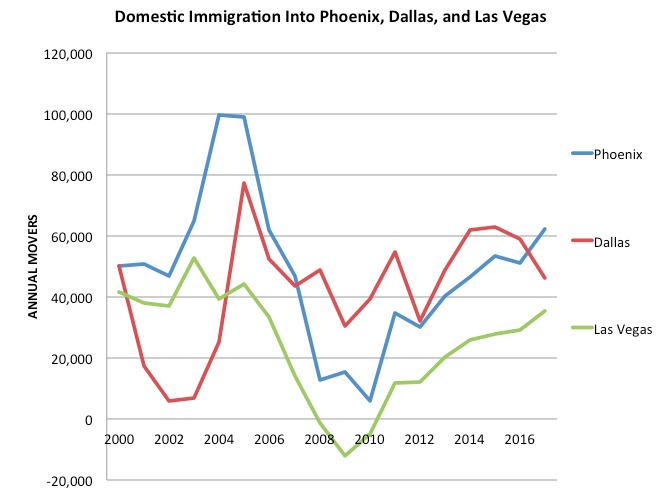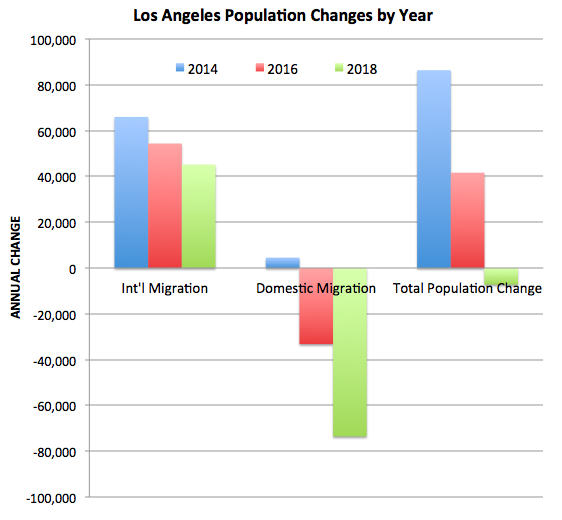Connecting state and local government leaders
After a post-recession boomlet, the New York, Los Angeles, and Chicago areas are all seeing their population decline.
Is this the age of the great metropolitan exodus? In 2018, the New York City area lost more than 100,000 people to other cities and suburbs—that’s 277 people leaving every day. The Los Angeles and Chicago areas lost, respectively, 201 and 161 residents each day. It’s quite a change from the post–Great Recession period, when an urban renaissance was supposedly sweeping the country and all three metro areas were experiencing a population boomlet.
To understand any metro’s migration picture, you have to know that the census keeps track of two types of movers. First, there are “domestic migrants,” or people who move from one U.S. address to another. Second, there are “international” movers, which mostly means immigrants. (Populations can also, of course, add new human beings the old-fashioned way: births. U.S. fertility rates are at record lows, and this statistic varies less from city to city.)
For many years, the New York, Los Angeles, and Chicago areas have seen more departures than arrivals among nonimmigrants. Domestic migration to these metros has been negative for most of the 21st century.

Also for many years now, America’s biggest metros have attracted high-income firms and young, highly educated workers. On the one hand, this phenomenon had led to the sparkling revitalization of many downtown areas, a golden age of fine dining, and an eerie urban selfsameness with green-plant-and-exposed-brick coffee shops and lunch-in-a-bowl restaurants. But on the other hand, this urban blossoming has also made many desirable downtown areas too expensive for non-rich people to start a family, forcing new parents to move out to the fringes of the metro, or leave entirely.
There’s little mystery about where people are heading, or why: They are mostly moving toward sun and some semblance of affordability. The major Texas metros—Houston, Dallas, San Antonio, and Austin—have collectively grown by more than 3 million since 2010. The most popular destinations for movers are now Phoenix, Dallas, and Las Vegas, which welcome more than 100,000 new people each year.

Until recently, domestic out-migration was counteracted by international immigration. From 2010 to 2018, immigration accounted for more than 100 percent of population growth in the New York, Chicago, and Philadelphia metros, and more than 80 percent of population growth in the Los Angeles and Boston areas, according to analysis by the Brookings Institution demographer William Frey.
What was celebrated as an urban renaissance was in large part an urban-immigration renaissance. In New York City’s five boroughs, the foreign-born share of the population increased from 18 percent in the 1970s to nearly 40 percent today, approaching its early 20th century highs. Following the 1965 Immigration Act, Los Angeles County’s immigrant population saw almost the exact same increase. Incidentally, this is a good thing: Families and young people moving to the U.S. from places such as the Dominican Republic, China, Mexico, and Vietnam enrich their new neighborhood’s culture, provide necessary labor—both “high skill,” like engineering, and “low skill,” like home health assistance—and generate a disproportionate share of new businesses.
In the past few years, however, population growth in the New York and Los Angeles areas has stalled. For the first time in decades, the nation’s two biggest metros are getting smaller at the same time. Immigrants aren’t coming in at the same rate they used to, and native-born Americans are leaving even faster. Why?
An easy answer is that America’s smaller metros have cheaper houses. This is especially true recently for Los Angeles, where insufficient housing development has contributed to a 75 percent increase in housing prices since the end of the Great Recession. What’s more, smaller cities and suburbs now offer similar knowledge-work jobs in a familiar residential aesthetic. In the past decade, urban developers, working off the Instagram blueprint, have standardized an MVMP—Minimum Viable Millennial Product—so that the move from Brooklyn to Boise means trading one set of hipster coffee shops, fast-casual joints, and cocktail bars for another set. Even the ground-floor retail differences between various metros becomes less important as more shopping moves online, where residents of every zip code are looking at the came social-media catalog and visiting the same digital mall.
To see what’s more deeply afflicting these metros, it’s useful to understand the plight of Chicago, whose growth after the Great Recession was just a blip in an otherwise long period of decline. Some of Chicago’s problems are unique among large metros. It sits on the far hip of the Rust Belt, hundreds of miles from the coastal economic juggernauts, and it has a homicide rate twice that of New York or L.A.
But in many ways, Chicago’s problems make it a canary in the metropolitan coal mine. Immigration to the area has declined by half since the early 2000s. High earners have swarmed the Chicago River banks, revitalizing the downtown area, but the more diverse middle class, especially the city’s African American population, is evacuating Chicago’s suburbs. During the Great Migration of the 20th century, when millions of black Americans moved to northern cities, the population of Chicago went from 4 percent black in 1920 to nearly 40 percent black by 1990. But this century has seen a “Reverse Great Migration,” as the metro black population is on pace to halve from its peak of 1.2 million by 2030. This could reflect a flight from high-crime neighborhoods and the racist legacy of redlining throughout Chicagoland. Less pessimistically, it might be a sign that a lot of young black families would just rather live where they can afford more house, like in the suburbs of Atlanta and Houston.
Each of these Chicago phenomena—declining immigration, revitalized downtowns coinciding with a middle-class exodus, and the specific decline of the black population—has spread from the heartland to America’s largest coastal metros.


First, immigration to both New York and Los Angeles has declined by 30 percent in the last five years. This could be for a variety of reasons, including the fear, and reality, of more restrictive immigration policies; richer and safer home countries; and a less affordable housing stock in these metros.
Second, higher-income residents bidding up the price of housing in both cities has accelerated the middle-class exodus. Earlier this decade, Los Angeles was the fastest growing county in all of southern California. But in 2018, it was the only major county in the region to shrink, even as its median home price set a new record—which strongly suggests the county could use more housing. As more middle-class families leave the Los Angeles area for cheaper markets in the West and Southwest—their preferred destinations: Las Vegas, Phoenix, and Dallas—California’s population growth has slowed to its lowest rate in state history. This might have something to do with the recent tax law, which, in capping the state and local deductions, effectively raised the cost of living in these places for the upper-middle class. (The next few years will tell us more about whether high earners are fleeing high-tax metros for the South, as well.)
Third, the black population of both New York and Los Angeles peaked in the early 2000s and has since been in steady, and perhaps accelerating, decline. The political implications of the first Great Migration were immense, as blacks moving into northern cities forged an alliance with urban liberals and pushed the Democratic Party to prioritize civil rights in the middle of the 20th century. The political implications of the Reverse Great Migration could be equally ground-shaking, if blacks moving south redraw the political map for the second time in 100 years. The slow decline of America’s largest metros may also mark the beginning of a new political movement in the suburbs of the South and Southwest.
In the 2020s, as in the 1960s, it may be said that movements begin with movers.
Derek Thompson is a Staff Writer at The Atlantic.

NEXT STORY: In Charleston, the Real Flooding Crisis Is Only Beginning



